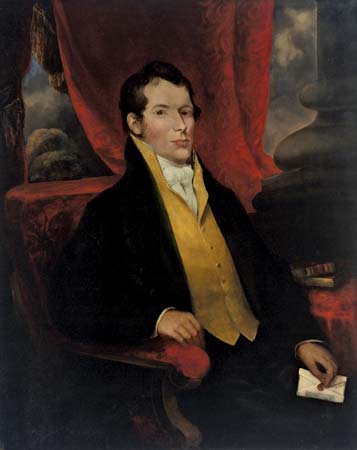Matthew Flinders (1774 - 1814) was an English explorer, naval officer and navigator from Lincolnshire, England, who became the first European person to circumnavigate Australia.
Bungaree (born about 1775), a Kuringgai man from the Broken Bay area of New South Wales, who accompanied Flinders on the voyage, was described by Flinders as a "worthy and brave fellow". Also along for the ride was Flinders seafaring cat, Trim.
 |
| Portrait of Captain Matthew Flinders, RN, 1774-1814 |
Mapping Australia
On 18 July 1801, Matthew Flinders left Portsmouth, England, in HMS Investigator with the intention of exploring the "unknown coast" of Australia, which was known as New Holland at this time.
Continuing along the coast, Flinders explored the site of the future city of Melbourne, before continuing eastwards, and reaching Port Jackson in May 1802. In that same month, Flinders recruited the Aboriginal man, Bungaree, who he described as having a "good disposition and open and manly conduct".
As Flinders finished the first complete map of Australia, proving that it was a single continent, Bungaree acted as a mediator, with the indigenous people that the voyagers encountered, even though he did not share a common language with most of the other tribes.
 |
| Add caption |
The Encounter
On 6 December 1801, Flinders arrived at the most south-westerly mainland point of the Australian continent, in the state of Western Australia and named it Cape Leeuwin, after the first known ship to have visited the area, the Dutch ship Leeuwin ("Lioness"), in 1622.
Continuing on, Flinders sailed along the southern coast of the Australian mainland, then stopped off at Oyster Harbour, Western Australia, where he found a copper plate that Captain Christopher Dixson had left there, only the year before, sailing on the Elligood. The plate was inscribed, "Aug. 27 1800. Chr Dixson, ship Elligood".
Whilst sailing off the coast of South Australia in 1802, Flinders came upon the French expedition, under the command of Nicolas Baudin, sailing Le Geographe. Although both expeditions believed that their countries were at war, both Flinders and Baudin as men of science discussed their findings before parting on good terms. Flinders and Baudin sailed in opposite directions and were never to meet again. Flinders did, however, name the bay in which they met, Encounter Bay.
Continuing on, Flinders sailed along the southern coast of the Australian mainland, then stopped off at Oyster Harbour, Western Australia, where he found a copper plate that Captain Christopher Dixson had left there, only the year before, sailing on the Elligood. The plate was inscribed, "Aug. 27 1800. Chr Dixson, ship Elligood".
Whilst sailing off the coast of South Australia in 1802, Flinders came upon the French expedition, under the command of Nicolas Baudin, sailing Le Geographe. Although both expeditions believed that their countries were at war, both Flinders and Baudin as men of science discussed their findings before parting on good terms. Flinders and Baudin sailed in opposite directions and were never to meet again. Flinders did, however, name the bay in which they met, Encounter Bay.
Bungaree
Continuing along the coast, Flinders explored the site of the future city of Melbourne, before continuing eastwards, and reaching Port Jackson in May 1802. In that same month, Flinders recruited the Aboriginal man, Bungaree, who he described as having a "good disposition and open and manly conduct".
As Flinders finished the first complete map of Australia, proving that it was a single continent, Bungaree acted as a mediator, with the indigenous people that the voyagers encountered, even though he did not share a common language with most of the other tribes.
Trim The Cat
Also on this voyage of circumnavigation around the Australian mainland, was Trim the cat. Trim was born in 1799 aboard the ship HMS Reliance, during a voyage from the Cape of Good Hope to Botany Bay. Flinders described the cat: "Trim as The sporting, affectionate and useful companion of my voyages during four years".
 |
| Bronze sculpture of Trim, on a windowsill of Sydney's Mitchell Library, was unveiled in 1997 |
How It Ends
The Investigator arrived back in Port Jackson in June 1803, after completing the circumnavigation of Australia.
On his return voyage to England, Flinders was accused of spying and imprisoned by the French in Mauritius. Sadly, Trim disappeared during Flinders's time in captivity.
Flinders returned to England in 1810, but he died one day after the publication of his great work, A Voyage to Terra Australis, in July 1814.
In 1814, Governor Lachlan Macquarie presented Bungaree with a brass breastplate and a large plot of land at George's Head, Port Jackson.
In January 1919, the grave of Matthew Flinders was found during excavations of a cemetery near Euston train station in London, as part of the HS2 high-speed rail project.
On his return voyage to England, Flinders was accused of spying and imprisoned by the French in Mauritius. Sadly, Trim disappeared during Flinders's time in captivity.
Flinders returned to England in 1810, but he died one day after the publication of his great work, A Voyage to Terra Australis, in July 1814.
In 1814, Governor Lachlan Macquarie presented Bungaree with a brass breastplate and a large plot of land at George's Head, Port Jackson.
In January 1919, the grave of Matthew Flinders was found during excavations of a cemetery near Euston train station in London, as part of the HS2 high-speed rail project.
Books To Read
Matthew Flinders' Cat, by Courtenay, Bryce.
Matthew Flinders' Cat, by Courtenay, Bryce.
















